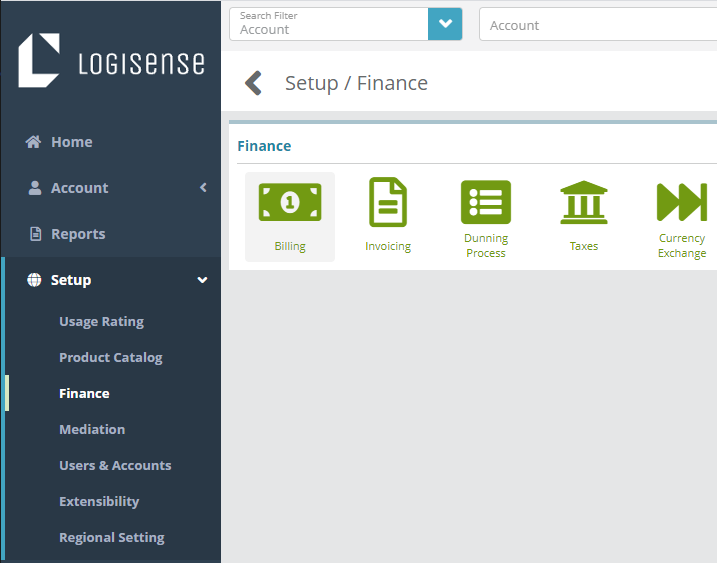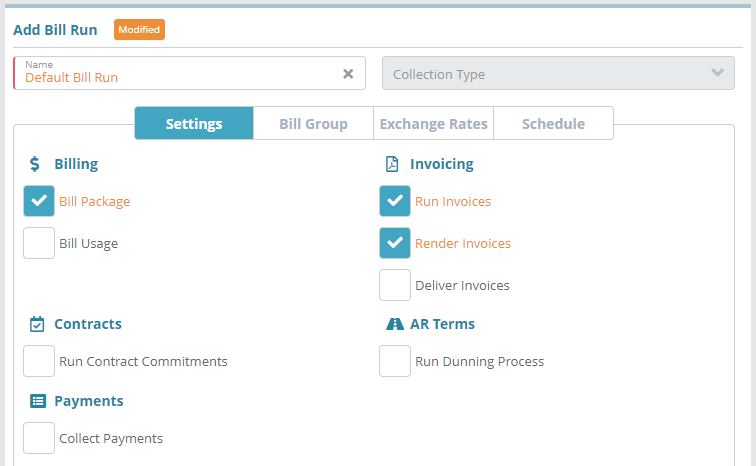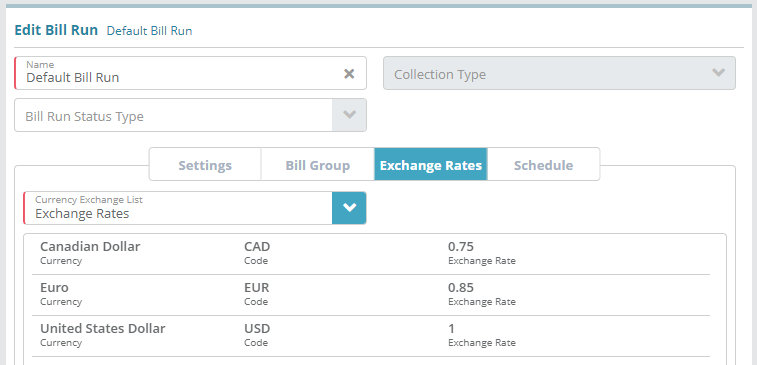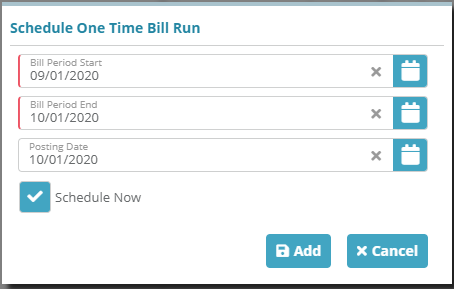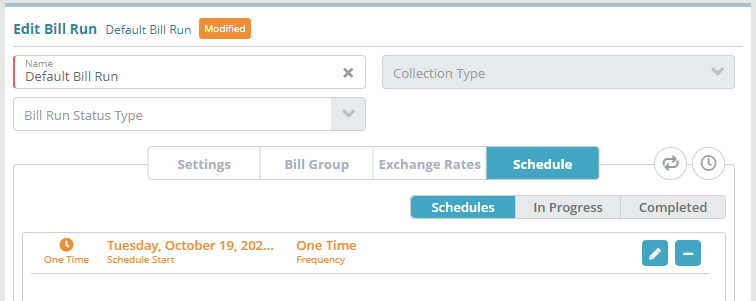...
Summary
Bill runs perform billing, invoicing and payment collection actions as well as execution of contract and accounts receivable terms (dunning rules). Bill runs can be triggered in either a manual 'one-off' fashion or using an automated recurring approach. The accounts that a bill run touches are determined by the bill groups that the accounts are under. Bill runs are associated with bill groups in order to bill accounts.
Bill runs can be set to run daily, however, executing a bill run does not mean billing, invoicing or other enabled bill run options will occur for every account that the bill run is evaluating. Bill runs check bill dates and other dates on accounts to determine if billing, invoicing and other bill run actions should occur. For instance, bill runs configured to bill packages will evaluate the 'next bill date' value on account-packages and only if bill dates have been reached will packages be billed.
Prerequisites
...
In this article we will cover how to setup and schedule a bill run that bills packages and generates an invoice.
For additional details on the fields presented on the bill runs screen see the Bill Runs Screen screen help article.
For an example on how to enable automatic payment collection on bill runs see the Bill Run Auto Pay Configuration Example.
Prerequisites
Currency exchange rates must be configured before bill runs can be setup
In Bill groups need to be setup in order to specify which accounts bill runs apply to bill groups need to be setupa bill run will bill
Sample Configuration
...
Creating a New Bill Run
Log into
...
the LogiSense Billing application
...
Click on the
...
Setup menu
...
3. Under Billing settings, Click on Bill Run.
...
Adding a Bill Runs
In this example below we will add a bill run set to bill packages and generate an invoice.
...
, Finance and then Billing
Under the Bill Runs heading click the
...
 button to add a Bill Run
button to add a Bill Run
...
Under
...
the Add Bill Run heading
...
give the bill run
...
a Name (e.g.
...
Click on Bill Packages to bills the account-packages that have a 'next bill date' that falls within the Bill Period (Bill Period Start to Bill Period End) date range.
...
Click on Run Invoices to stamp transactions with an invoice number.
...
Click on Render Invoices to generates invoices.
Fig-1
Bill group called “Test BG” is associated with this Bill run as shown in Fig-2
Fig-2
Click Save. Bill Run will be created.
Schedule a Bill Run
...
'Default'). In the example shown below the bill run has been set to bill packages and generate an invoice on the billed accounts.
To specify the accounts that the bill run should bill it needs to be associated with one or more bill groups. Click on the Bill Group tab to select an existing bill group. In this example a bill group called ‘Default Bill Group’ is being added to the bill run (shown in the image below)
Next select the Exchange Rates tab and select the exchange rates to use when billing
Click Save to create the bill run
Scheduling a One-Time Bill Run
In the example below we will add a one time bill run to bill the accounts that are under a bill group.
For example Bill Group called “Test BG” has two accounts under it as shown in Fig-3.
...
Fig-3
...
Go to the Bill Runs and under Bill Run heading on the left click the “Test BR” bill run.
...
Ensure you have setup a bill group under the Setup / Finance / Billing / Bill Group screen
Navigate to the bill runs screen and ensure you have a bill run setup
Select the bill run and under the Edit Bill Run panel on the right click on
...
the Schedule tab
To schedule a one time bill run click
...
the
 icon next to Schedule tab
icon next to Schedule tab
...
On the
...
modal that appears specify when the bill run should
...
Fig-4
Click on Save as shown in Fig-5
...
Fig-5
Once Bill Run is completed, it will show under Completed tab as shown in Fig-6
...
Fig-6
Go to the account and it will show that the invoice is generated with package (subscription) charges.
...
Next Steps
<<documentation team task: link to next configuration article>>
Related Guides
<<documentation team task: link to API guide which covers the same config process>>
...
occur (e.g. ‘Schedule Now’) and the Billing period start and end dates. The dates will determine if a account-package is billed based on the account-package bill date (e.g. an account-package with a bill date of Nov 1st 2020 will not bill based on the bill period range set in the image below)
Click Add and then Save to add the one-time scheduled bill run
The bill run will now be listed on the Scheduled tab
Click Save on the Bill Run to save the schedule set and the bill run will execute
Result
Setup / Finance / Billing / Bill Runs
When the scheduled bill run executes and finishes it will indicate when it started and completed on the Completed tab
...
Account / Billing / Invoices
When accounts are setup and billed by the bill run as configured above an invoice will be generated for transactions on the account within the bill run’s billing period.
To see the invoice that is generated along with the with package (subscription) charges load an account under the bill group that the bill run billed and access the Invoices screen.
...
Next Steps
Optional: If you utilize General Ledger codes you can configure these now or at a later time. See the General Ledger (GL) Code Configuration Example article for a configuration example
You have now configured the system to the point where the products you wish to sell can be setup. The first step is to setup service types which are used when configuring services. See the Service Type Configuration Example for an example of how to setup service types
